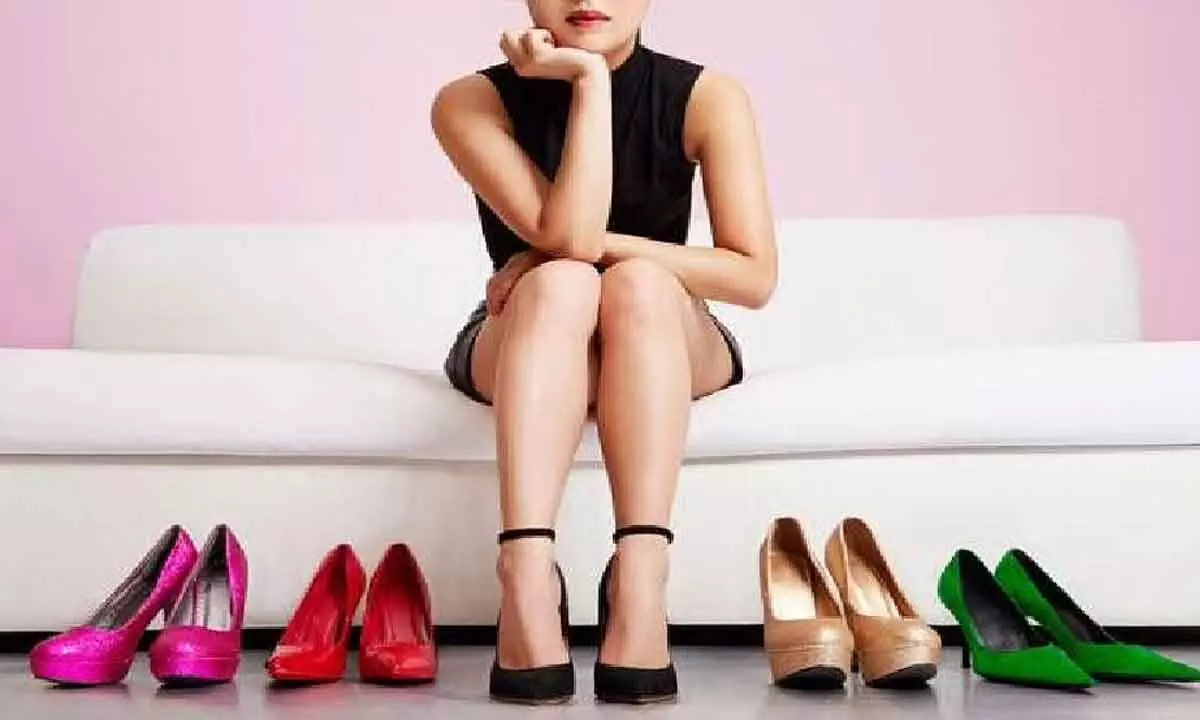Just In

High heels that are 3 cm are the most comfortable to walk in
Women have worn heels for many years, and they have now firmly established them-selves in both western and Indian wardrobes. According to recent studies, up to one-third of women experience chronic issues as a result of wearing high heels for an extended period of time. According to a recent survey, one-third of the women who wear it at least three days a week (one in 10) experience ongoing issues.
"Women have worn heels for many years, and they have now firmly established them-selves in both western and Indian wardrobes. According to recent studies, up to one-third of women experience chronic issues as a result of wearing high heels for an extended period of time. According to a recent survey, one-third of the women who wear it at least three days a week (one in 10) experience ongoing issues. Wearers of high heels experi-ence altered gait patterns. Compared to those who regularly wear flat shoes, the average person who wears heels walks with shorter and more pronounced strides," says Dr. Man-an Vora, Orthopaedic Surgeon, Sports Medicine Expert & Content Creator.
"With habitual wearing of heels two inches or higher, the Achilles tendon and calf mus-cles can face changes in shape. As the shoe heel pushes up the human heel, the Achil-les tendon and calf muscles are facing increased pressure. The tendon may shorten, and the muscles can stiffen and reshape. This can occur in individuals who frequently wear heels, and can create pain in the body's lower extremities," Dr Manan adds.
If you are feeling the consequences of constantly wearing heels, Dr. Manan shares steps you can take to help combat the aching and discomfort. These suggestions can help de-crease the pain you are feeling from wearing high heel shoes.
♦ Change your shoe choice – Go for flat shoes, or shoes that provide more support and cushion.
♦ Switch up your exercise routine – Reduce frequent stress on your knees, hips, and lower back while exercising. Rowing, swimming, and the elliptical are low-impact types of exercises that are easier on your joints.
♦ Minimize the amount of days you wear heels – Try adding flats or wedges to your shoe selection.
♦ Go for a shorter heel – Heels two inches or less put less pressure on joints.
♦ Stretch your calves before and after wearing heels – Allow yourself time for lunges or other calf-stretching methods.
♦ Place cushions in your shoes and heels – Make your shoe choices more comfort-able for your feet.
While completely stopping to wear heels isn't feasible, here are a few tips that you can keep in mind while purchasing and wearing your favourite heels.
♦ While purchasing heels, make sure you buy the right size that fits you well. If you buy a bigger size, you can fall. If you buy a smaller size, it can be tight thereby causing pain.
♦ Some of us have narrow feet, some have wide, some have smaller toes, while some might have long toes. There are so many variations. If you have wide feet, do not to wear closed tapered shoes, wear wide front closed ones or open toe ones. Even those with smaller toes should opt for closed wide front shoes. The pointed front shoes will pinch your toes and make it very uncomfortable. Heels that cramp your toes will cause pain when walking and increase the possibility of get-ting bunions, corns and developing hammertoes and even arthritis later in life.
♦ Wearing heels puts more pressure on your feet, especially the balls of the feet. Be-fore purchasing that coveted pair, check that they have proper padding and cush-ioning in the area that supports the balls of feet. High heels with excellent cush-ioning and padding provide great support and comfort to your feet.
♦ When choosing high-heels, check where the heel is placed. The heel should ide-ally be placed under your own heel. Remember, thicker the heel, the greater the support it provides for your body. Look for platforms that will distribute your weight across the entire foot evenly instead of concentrating it at the ball of the foot or the heel. So, go for wider, thicker heels if you want to decrease the risk of sprained an-kles.
♦ High heels that are 3 cm to 9 cm high are the most comfortable to walk in. Heels more than that height put more pressure on your lower back, knees, ankles and do not give any support for balancing.
♦ Give your feet a break. When wearing high heels, the best advice you can take to prevent pain is just to sit down whenever possible! This will give your feet a break and will stop any pain or discomfort from building, keeping your feet fresh.
♦ Don't wear high heels too often. High heels look fabulous, but save them for spe-cial occasions only.

© 2024 Hyderabad Media House Limited/The Hans India. All rights reserved. Powered by hocalwire.com







